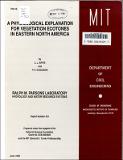A Physiological Explanation for Vegetation Ecotones in Eastern North America
Author(s)
Arris, L. L.; Eagleson, P. S.
Download21484409.pdf (13.01Mb)
Metadata
Show full item recordAbstract
Prediction of the vegetative cover of land surfaces as climatic conditions change is an important aspect of general circulation models that has not been adequately explored. In this study, a model is developed for the purpose of predicting the location of two major vegetation ecotones in eastern North America based on the interaction of plant physiological characteristics, climate, and edaphic influences. The model represents the relative competitive ability of different vegetation types by their annual net primary productivity. At any given location, the vegetation type with the highest productivity is predicted to be the dominant type. Ecotones are located where competitive dominance shifts from one vegetation type to another. Productivity is computed as a function of annual evapotranspiration, which is a function of the length of the growing season, photosynthetic capacity, potential evapotranspiration, and soil moisture availability, among other things. When considering the boreal/deciduous forest ecotone, it is found that inherent physiological differences between conifers and deciduous trees lead to differences in productivity which are related primarily to temperature. The model predicts deciduous dominance to a latitude slightly north of the observed ecotone location. However, an absolute physiological limit in the form of low temperature tolerance is apparently preventing the deciduous forest formation from further northward migration. It was necessary to include soil characteristics when considering the deciduous/southern pine ecotone. Water limitations apparently play a role in the determination of this boundary, although the model results indicate that an additional limiting factor is also operating at this ecotone. It is suggested that nutritional limitations may be present as a result of the soil characteristics of the region, and that this may contribute to the dominance of pine in the south.
Description
Supported by the NSF grant ECE-8603628. Supported by the MIT Edmund K. Turner Professorship and an Ida M. Green graduate fellowship.
Date issued
1989-06Publisher
Cambridge, Mass. : Ralph M. Parsons Laboratory, Hydrology and Water Resource Systems, Massachusetts Institute of Technology, Dept. of Civil Engineering
Other identifiers
323
Series/Report no.
R (Massachusetts Institute of Technology. Department of Civil Engineering) ; 89-16.Report (Ralph M. Parsons Laboratory for Water Resources and Hydrodynamics) ; 323.